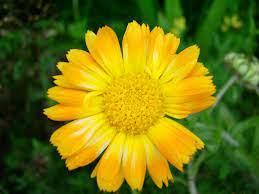
The capitulum type of inflorescence is found in
A. Marigold, Sunflower
B. Salvia, Ocimum
C. Euphorbia, Ficus
D. Ocimum, Ficus
Answer
482.7k+ views
Hint: An inflorescence is an assortment or cluster of flowers assembled on a stem that is accumulated of a major branch or a complex pact of branches. Morphologically, it is the modified part of the shoot of seed plants where flowers are produced. Inflorescences are described by many diverse characteristics including how the flowers are assembled on the peduncle, the blooming order of the flowers.
Complete answer: Verticillaster consists of biparous cymes ending in uniparous scorpioid cymes on either side. Examples are salvia and Ocimum.
Hypanthodium - In this type of inflorescence the receptacle becomes globular with a cavity within. It opens to the outside with a little opening. Numerous small sessile flowers are created from the internal surface of the receptacle. e.g., Ficus.
Cyathium type of inflorescence is found in the family Euphorbiaceae. In this inflorescence there is a cup-shaped involucre, often provided with nectar liberating glands.
In capitulum inflorescence, the peduncle is flat and the florets are assembled in a centripetal way. The entire cluster of florets is surrounded by a whorl of bracts known as an involucre. The receptacle is flat. Florets are bracketed in Marigold. Examples are marigold, sunflower.

So, the correct answer is “Option A”.
Note:
Certainly, the most remarkable plants to present their flowers in a capitulum are those in the aster family, Asteraceae. Also known as the Compositae because their capitulum often includes two types of flowers in a specially mixed cluster, these capitulos often look like large individual blossoms. The flowers are independently tiny; aggregation in a capitulum assists assembly-line pollination. A single floral visitor can carry pollen to and remove it from many flowers in one foraging.
Complete answer: Verticillaster consists of biparous cymes ending in uniparous scorpioid cymes on either side. Examples are salvia and Ocimum.
Hypanthodium - In this type of inflorescence the receptacle becomes globular with a cavity within. It opens to the outside with a little opening. Numerous small sessile flowers are created from the internal surface of the receptacle. e.g., Ficus.
Cyathium type of inflorescence is found in the family Euphorbiaceae. In this inflorescence there is a cup-shaped involucre, often provided with nectar liberating glands.
In capitulum inflorescence, the peduncle is flat and the florets are assembled in a centripetal way. The entire cluster of florets is surrounded by a whorl of bracts known as an involucre. The receptacle is flat. Florets are bracketed in Marigold. Examples are marigold, sunflower.

So, the correct answer is “Option A”.
Note:
Certainly, the most remarkable plants to present their flowers in a capitulum are those in the aster family, Asteraceae. Also known as the Compositae because their capitulum often includes two types of flowers in a specially mixed cluster, these capitulos often look like large individual blossoms. The flowers are independently tiny; aggregation in a capitulum assists assembly-line pollination. A single floral visitor can carry pollen to and remove it from many flowers in one foraging.
Latest Vedantu courses for you
Grade 10 | MAHARASHTRABOARD | SCHOOL | English
Vedantu 10 Maharashtra Pro Lite (2025-26)
School Full course for MAHARASHTRABOARD students
₹33,300 per year
Recently Updated Pages
Master Class 11 Economics: Engaging Questions & Answers for Success

Master Class 11 Business Studies: Engaging Questions & Answers for Success

Master Class 11 Accountancy: Engaging Questions & Answers for Success

Master Class 11 English: Engaging Questions & Answers for Success

Master Class 11 Computer Science: Engaging Questions & Answers for Success

Master Class 11 Maths: Engaging Questions & Answers for Success

Trending doubts
State and prove Bernoullis theorem class 11 physics CBSE

1 ton equals to A 100 kg B 1000 kg C 10 kg D 10000 class 11 physics CBSE

State the laws of reflection of light

One Metric ton is equal to kg A 10000 B 1000 C 100 class 11 physics CBSE

1 Quintal is equal to a 110 kg b 10 kg c 100kg d 1000 class 11 physics CBSE

Difference Between Prokaryotic Cells and Eukaryotic Cells




